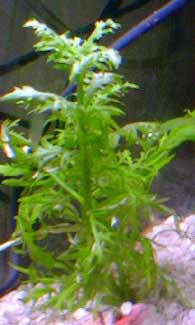
Water Wisteria
This photo shows a "starter sprig" of Water Wisteria (Hygrophila difformis) that was grown anchored in gravel substrate, thus it has slender lacey leaves & upright growth. When a young plant grows up as a floating wisteria, the leaves are much fatter in their branching, & the plant grows flat on the surface. Sometimes young plants, which develop all along the main leaves as tiny & already-rooted wisterias, accumulate on the surface so thickly that a third growth behavior occurs, that of nearly "curled" balls of wisteria superb for fish fry to hide in at the surface.
A gravel-rooted wisteria will grow larger & larger for several months, but eventually it starts producing young plants on its leaves, & the whole specimen begins to fall apart to float to the surface as numerous young plants. Any of these can be inserted into the gravel to create a new upright specimen with finer ferny leaves. The majority of the floaters are usually removed & composted so that a few specimens have a chance to become large-leafed specimens with big leaves floating flat to the surface, & a dangling root system cleaning impurities from the water to get nutrients.
Some people feel they have failed with wisteria when a gravel-planted specimen reaches its height of beauty then completely "falls apart" with its numerous babies. But if one expects this cyclic behavior, there will be no disappointment, & it is one of the easiest of all aquarium plants to watch self-propogate like crazy.
It thrives in most lighting conditions from medium to much. It can grow so darned well that it shades & suffocates all other plants. The best way to deal with it is to periodically pull it out the gravel, discard the rooted lower portion, & restart it from a couple of the handsomest bits off the top. The first couple times one does this it can be painful to toss, of all things, the roots, but saving the root of trimmed specimens is not the best way to keep it fresh.
Plants treated in this manner might never reach that "mature" stage when they begin developing baby plants on all the leaves, & so the main plant never needs to fall apart, but if left to its own devices t gets bigger & bigger until its ready to let loose with lots of youngsters. All the trimmed scraps of an often-restarted single specimen are capable of generating new plaints, either floating or gravel-rooted, so it's not like one must let the plant start producing complete miniatures of itself along the leaves in order to get multiple plants.
I've grown this native of Asia Minor & Southeast Asia since I was a child, but as most of my tanks during the past decade have been for land-amphibians, I hadn't had wisteria for a while. In January (2004) I set up a deep tank for a fully aquatic dwarf siren to live with some guppies, & so right away got a small start of wisteria. In the past when I've done this I always plant it in the gravel & wait for it to mature & produce offset babies, then in the long-run let the majority of the plant become surface-plant since its roots provide such a wonderful natural filter to keep the tank wholesome without requiring water-changes, & a place for baby guppies to hide. In the long run there will be so much wisteria floating on the surface that big nets of it can be removed to plant elsewhere, give away, or merely compost.
Savvy aquarium stores like to sell various fertilizing methods for aquarium plants & some plants benefit from these extra products, but the often repeated insistance that wisteria needs fertilizing is so bullshitty as to constitute a scam to squeeze extra money from the customer. If fish or aquatic amphibians live with it, it will need no fertilizing at all to reach its potential foot-tall very thick bushiness, & in general grows so fast that attempting to get it to grow any faster is silly.
I like undergravel filters because they cause benificial bacteria to thrive in the gravel, which break down fish poops into nitrogens & other nutrients used by the plants, & a tank set up for any length of time has healthful silty loam mixed into the gravel which rooted plants adore. Furthermore, floating specimens keep the water so clean that there will be neither pollutants to bother the fish, nor sufficient left-over nutrients to excite algae growth. Only when introduced into a totally sterile aquarium without animal life in it would substrate fertilizers, CO2 fertilizer, & iron supplementation be called for. So don't waste money on plant-support products which wisteria in particular does not require.
As a tropical plant it generally does not thrive in an outdoor pond, as it will die the first winter. But in warmer climates it is potentially an invasive weed that will out-compete & threaten native plants, so should be guarded against.